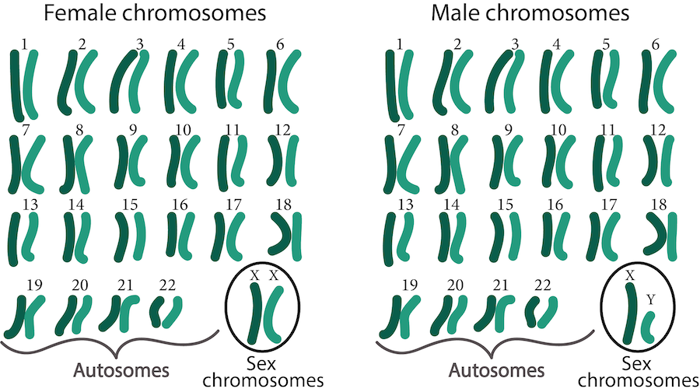
Since only one of a woman’s X chromosomes works in a cell, why aren’t more women colorblind?
March 4, 2010

- Related Topics:
- Color vision deficiency,
- X inactivation,
- Carrier,
- X linked inheritance
A curious adult from California asks:
"Since only one of a woman's X chromosomes works in a cell, why aren't more women colorblind?"
Great question! Colorblindness definitely hits men more than women. In standard tests, around 8% of all males and only 0.4% of all females are red-green colorblind.
But given that only one of a woman's X chromosomes is turned on at any one time, you'd think more women should be colorblind. Maybe somewhere around 3%. So what's going on?
The truth is that there are more women who are colorblind than is commonly advertised. It is just that women who are carriers of colorblindness are only affected a little bit. Too little in fact to be noticed except with very sensitive tests.
The reason for this is that these women actually have a mix of cells in their eyes. Some of these cells can sense color and others can't. Usually, enough of these cells are working that these women don't have much trouble telling red from green in their daily lives.
To understand how and why this all happens, we need to step back a bit and talk about the genetics of colorblindness. We also need to chat a bit about how something called X inactivation works. From that you'll see why carriers of colorblindness do have a bit of trouble telling red from green.

Red-Green Colorblindness
At the back of your eye is a layer of cells called the retina. The retina has cells called rods and cones that let you see.
Rods help you see in the dark — they detect whether or not light is there. Cones are the cells that detect color, so they are the ones we're interested in here.
You have three different types of cones that help you see different parts of the color wheel. All three cones work together to give you color vision.
The colorblindness we're talking about here is red-green colorblindness. This happens when one of the three cones can no longer sense color.
People end up red-green colorblind when they have no working copies of a certain opsin gene. Because this gene is found on the X-chromosome, more men than women have trouble telling red from green.
This is because women usually have two copies of the X chromosome while men usually have just one. If a man inherits a nonworking opsin gene on his X-chromosome from his mother, he will be colorblind. This is because most men only have one X-chromosome (they inherit a Y-chromosome from their dads).
Meanwhile, if a woman inherits the nonworking gene from one of her parents, she usually still has another X-chromosome with a working gene. The working one compensates for the nonworking one.
At least this is how it would work if women really had two working X-chromosomes. But they don't because of something called X-inactivation.

X-inactivation
As I said before, most women have two X chromosomes and most men have an X and a Y. What this means is that women have two copies of all of the genes on the X chromosome while men have just one. (The Y has only a few genes and they all deal with being male so we can ignore it.)
Having lots of extra or missing genes is usually not good for someone. It can cause all sorts of symptoms ranging from Down syndrome to death.
So our cells needed to come up with a way to solve that problem. In people (and lots of other animals), the cells shut off or inactivate one of the female's X-chromosomes. Now males and females essentially have one copy of each gene on this chromosome.
The chromosome that is inactivated is wrapped up and tied in knots so that it can't be used by the cell anymore. And the decision of which X-chromosome is inactivated is random.
This decision is made on a cell by cell basis when the embryo is made up of only a few hundred cells. All of the daughter cells that come from these cells will have the same X-chromosome inactivated. So you have a couple hundred random tosses of the coin to decide which X-chromosome is used. And all the cells in your body (trillions of them!) come from these cells which decided which X-chromosome to inactivate and which to express.
This is why, for example, calico cats have patches of different colors. Because each patch comes from one cell that decided to inactivate one of its X-chromosomes. And the patch next to it comes from another cell that decided to inactivate the other X-chromosome.

What is obvious in a Calico is less obvious in people but happens too. So some cells in a woman's body might be using their father's X-chromosome.
Meanwhile, cells right next to it might be using their mother's X-chromosome. And because the human eye comes from several different cells, some will have one X-chromosome inactivated while the rest have the other.
And this is why a woman who is a carrier for colorblindness can still tell red from green. Because some of the cells in her eyes have the X with the working copy of the opsin gene active.
These cells are enough for her not to be as colorblind as someone with no working opsin genes. But she can't tell red from green as well as someone who has all their cells working.
Carriers are Different
Scientists have tested women with two working opsin genes against women who carry a nonworking copy. They found that the groups perform differently in certain vision tests.
For instance, when colorblind people look at Ishihara plates, they only see random dots. People with normal color vision see numbers hidden in the different colors.
Carriers of colorblindness see the numbers hidden in the Ishihara plates under normal light. But, when they look at the plates illuminated under a green light, they tend to make many more mistakes compared to women with normal color vision.
Carriers also have some trouble seeing lights of a certain color when they are flashed in parts of their peripheral vision. And there are probably other minor problems too.
But in everyday life, it would be hard to tell the two groups apart. For all intents and purposes, carriers are not colorblind.
And that's why there aren't more women who are colorblind despite X-inactivation.

Author: Shuai Chen
When this answer was published in 2010, Shuai was a Ph.D. candidate in the Department of Cancer Biology, studying protein methylation and its effects in Or Gozani’s laboratory. Shuai wrote this answer while participating in the Stanford at The Tech program.
 Skip Navigation
Skip Navigation
